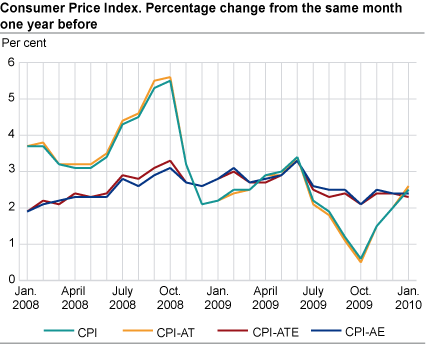Content
Published:
This is an archived release.
Electricity prices raised the CPI
The CPI increased by 0.2 per cent from December 2009 to January 2010. The prices on electricity including grid tariff contributed most to the growth. The CPI rose by 2.5 per cent from January 2009 to January 2010, while CPI-ATE increased by 2.3 per cent in the same period.
The consumer price index (CPI) was 127.1 (1998=100) per January 2010, compared to 124.0 at the same time in 2009. This corresponds to a year-to-year growth of 2.5 per cent in January 2010, up from 2.0 per cent the previous month. The year-to year growth in the CPI-ATE was 2.3 per cent in January 2010, compared to 2.4 per cent in December 2009.
CPI up 0.2 per cent
The CPI rose by 0.2 per cent from December 2009 to January 2010. The most important factor behind the growth was an increase in electricity prices included grid tariff of 11.6 per cent. Both electricity prices and grid tariffs rose sharp. Actual rentals for households and imputed rentals for households increased by 1.6 and 1.3 per cent respectively. The prices of fuels and lubricants rose by 2.5 per cent from December to January, and also contributed to the increase in the CPI. Tobacco prices rose by 5.8 per cent in the same period, mostly due to tax increases. The CPI-AT rose by 0.1 percent, and changes in taxes contributed in pulling the CPI up by 0.1 percentage points.
The prices of cultural services rose by 2.1 per cent. The prices of after-school care rose some from August 2009, while household payments in kindergartens rose marginally. See new article for household payments for kindergartens .
Sales on clothing and shoes dampened the rise in the CPI from December to January. These prices fell by 8.6 per cent. Prices of furniture, furnishings and decorations also fell due to sales, by 5.7 per cent in the same period. The increase in CPI was also dampened by airline fares, which fell by 17.4 per cent. Prices of food and books also declined.
Consumer prices has risen by 2.5 per cent the last twelve months
The CPI increased by 2.5 per cent from January 2009 to January 2010. The most important factors to the year-to-year growth were the prices of actual rentals for households and imputed rentals for households, and the prices for regular maintenance and repair of dwellings. Actual rentals for households and imputed rentals for households increased by 2.6 and 2.5 per cent respectively. Other important contributors to the rise were the prices of fuels and lubricants, which increased by 13.6 per cent. Food prices rose by 2.5 per cent in the same period, while prices of recreational and cultural services rose by 6.8 per cent.
Airline fares fell by 18.4 from January 2009 to January 2010 and contributed in dampening the growth in the CPI.
Electricity prices behind rise in year-to-year growth
The year-to-year growth in the CPI rose by 0.5 percentage points, up from 2.0 in December 2009 to 2.5 in January 2010. The most important factor to this rise was the development of prices of electricity including grid tariff. The prices of electricity including grid tariff rose by 11.6 per cent from December to January, while they decreased by 3.0 per cent in the same period a year ago. Another factor to the rise in the year-to-year growth was the prices of clothing and shoes, which fell less in January 2010 compared to January 2009.
The year-to-year growth in the CPI-ATE declined 0.1 percentage point, from 2.4 per cent in December 2009 to 2.3 per cent in January 2010.
| Weights | Index | Change in per cent | |||||||||||||||||||||||||||||||||||||||||||||||||||||||||||||||||||||||||||||
|---|---|---|---|---|---|---|---|---|---|---|---|---|---|---|---|---|---|---|---|---|---|---|---|---|---|---|---|---|---|---|---|---|---|---|---|---|---|---|---|---|---|---|---|---|---|---|---|---|---|---|---|---|---|---|---|---|---|---|---|---|---|---|---|---|---|---|---|---|---|---|---|---|---|---|---|---|---|---|---|
| August 2009- July 2010 |
January 2010 | December 2009- January 2010 |
January 2009- January 2010 |
||||||||||||||||||||||||||||||||||||||||||||||||||||||||||||||||||||||||||||
| CPI All-item index | 1 000.0 | 127.1 | 0.2 | 2.5 | |||||||||||||||||||||||||||||||||||||||||||||||||||||||||||||||||||||||||||
| Food and non-alcoholic beverages | 114.4 | 121.5 | -0.8 | 2.4 | |||||||||||||||||||||||||||||||||||||||||||||||||||||||||||||||||||||||||||
| Alcoholic beverages and tobacco | 25.5 | 147.0 | 2.4 | 4.0 | |||||||||||||||||||||||||||||||||||||||||||||||||||||||||||||||||||||||||||
| Clothing and footwear | 56.3 | 56.3 | -8.6 | 1.3 | |||||||||||||||||||||||||||||||||||||||||||||||||||||||||||||||||||||||||||
| Housing, water, electricity, fuels | 304.7 | 156.0 | 2.6 | 2.4 | |||||||||||||||||||||||||||||||||||||||||||||||||||||||||||||||||||||||||||
| Furnishings household equipment | 61.8 | 104.8 | -2.2 | 0.7 | |||||||||||||||||||||||||||||||||||||||||||||||||||||||||||||||||||||||||||
| Health | 26.1 | 149.0 | 0.2 | 2.8 | |||||||||||||||||||||||||||||||||||||||||||||||||||||||||||||||||||||||||||
| Transport | 172.1 | 135.3 | - | 2.7 | |||||||||||||||||||||||||||||||||||||||||||||||||||||||||||||||||||||||||||
| Communications | 22.7 | 73.5 | -0.1 | -0.3 | |||||||||||||||||||||||||||||||||||||||||||||||||||||||||||||||||||||||||||
| Recreation and culture | 120.6 | 115.4 | - | 3.6 | |||||||||||||||||||||||||||||||||||||||||||||||||||||||||||||||||||||||||||
| Education | 2.4 | 163.1 | - | 3.3 | |||||||||||||||||||||||||||||||||||||||||||||||||||||||||||||||||||||||||||
| Restaurants and hotels | 35.3 | 148.1 | 0.4 | 2.6 | |||||||||||||||||||||||||||||||||||||||||||||||||||||||||||||||||||||||||||
| Miscellaneous goods and services | 58.1 | 135.3 | 0.7 | 3.8 | |||||||||||||||||||||||||||||||||||||||||||||||||||||||||||||||||||||||||||
| CPI-AE | 121.9 | -0.4 | 2.4 | ||||||||||||||||||||||||||||||||||||||||||||||||||||||||||||||||||||||||||||
| CPI-AT | 124.0 | 0.1 | 2.6 | ||||||||||||||||||||||||||||||||||||||||||||||||||||||||||||||||||||||||||||
| CPI-ATE | 118.8 | -0.6 | 2.3 | ||||||||||||||||||||||||||||||||||||||||||||||||||||||||||||||||||||||||||||
| CPI-ATE sesonal adjusted | 119.8 | 0.3 | |||||||||||||||||||||||||||||||||||||||||||||||||||||||||||||||||||||||||||||
Tables
Contact
-
Statistics Norway's Information Centre
E-mail: informasjon@ssb.no
tel.: (+47) 21 09 46 42
-
Konsumprisindeksen
E-mail: konsumprisindeksen@ssb.no
tel.: (+47) 62 88 56 34
-
Camilla Rochlenge
E-mail: camilla.rochlenge@ssb.no
tel.: (+47) 40 90 23 72
-
Kjersti Nyborg Hov
E-mail: kjersti.nyborg.hov@ssb.no
tel.: (+47) 40 90 23 63
-
Gunnar Larsson
E-mail: gunnar.larsson@ssb.no
tel.: (+47) 40 90 26 79
-
Trym Kristian Økland
E-mail: trym.okland@ssb.no
tel.: (+47) 46 81 09 15

